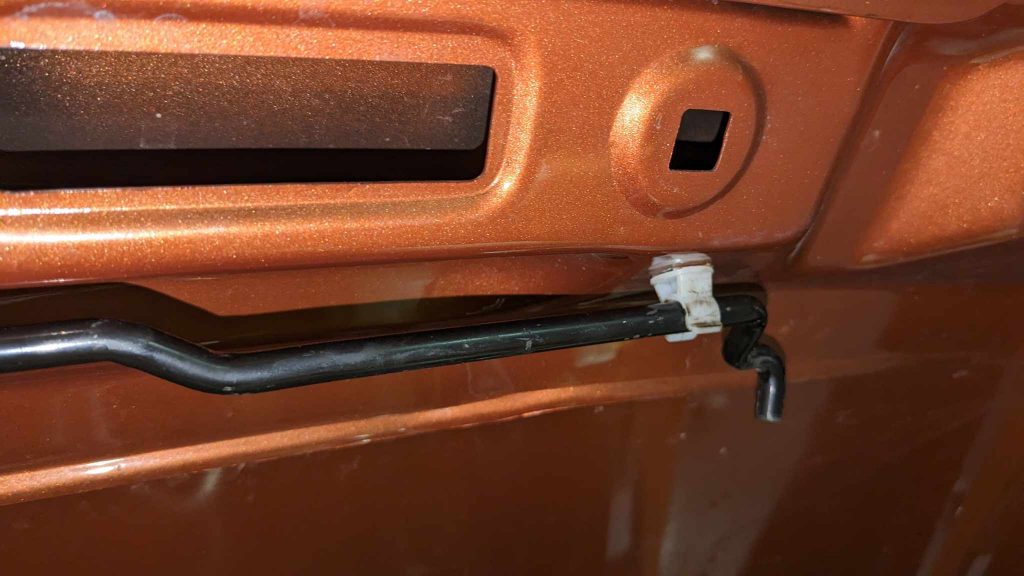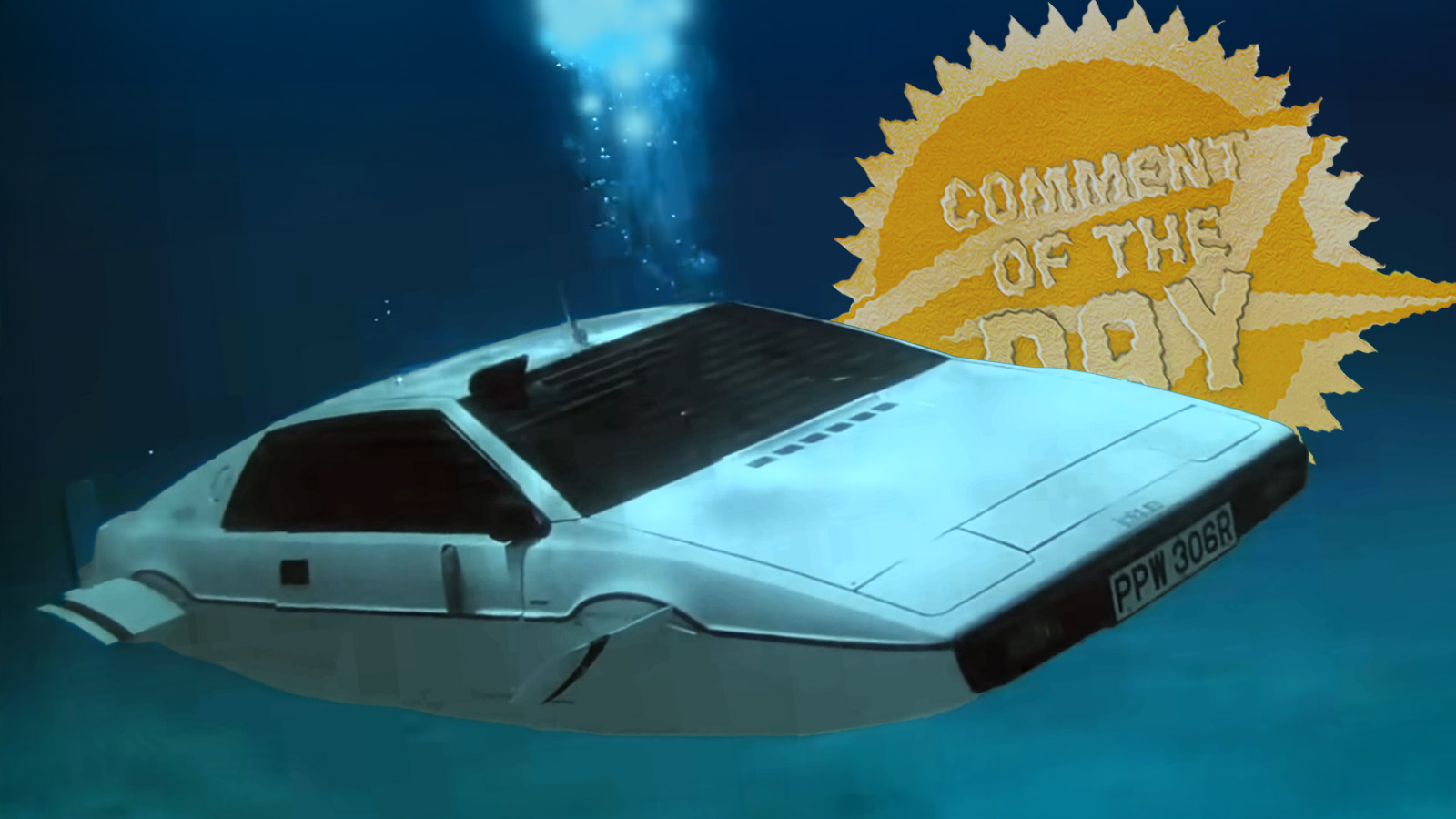“Mr. Tracy, [Matt] Farah is wondering if you know a trustworthy Jeep mechanic in LA? He has a client 1999 with a misfire” read the chat message from talented auto writer Zack Klapman. As I’m new to LA and do all my own work anyway, I did not know a mechanic — well, except one: me. Zack floated the idea to Matt, who agreed to let me wrench on this TJ. “It’s just a misfire, probably just needs a tuneup,” I thought to myself. Oh boy was I wrong. The Jeep needed lots of work, and I — as editor-in-chief of this website you’re now reading — didn’t have a lot of time. So I girded my loins and went all-out. Here’s how that went.
Upon arrival at Matt’s beautiful business, Westside Collector Car Storage in Culver City, California, I gazed upon a beautiful orange Jeep with aftermarket fender flares, an ARB front bumper, and big 33-inch tires. I fired up the 125,000 mile 4.0-liter straight six and popped the hood:

The engine sounded perfect! “There’s no misfire here,” I said aloud as I held my hand to the engine’s valve cover to feel for any unusual vibration. “Also, this is clearly not a 1999.” I knew this latter fact because 1999 Jeep Wranglers have distributors; the engine I was looking at clearly had a long plastic ignition coil housing running above the six spark plugs on the passenger’s side. The tuneup kit — distributor cap, rotor, plug wires, plugs — I’d purchased would now be mostly useless (I could still use the plugs), but that’s OK because this vehicle clearly didn’t need a tuneup. The engine of this 2002 Jeep Wrangler (it said the year on the vehicle’s door tag) was running great.
I was confused about why I was even there until one of Matt’s employees, Adam, told me about the Check Engine light. That had to be mended to get the vehicle through emissions testing, meaning now instead of doing a basic tuneup to fix a misfiring 1999 Jeep 4.0, I was trying to track down some minor fault in a 2002 Wrangler’s emissions system.
My OBD scanner told me there was an issue in the EVAP system, and that there was a misfire, though I doubted the latter point (maybe it said lean condition? I can’t remember, but that’d make more sense). Luckily, it took me only five minutes to find a bad hose going from the charcoal canister to the intake manifold:


I went to AutoZone, picked up a new bit of hose and a new elbow, slid those over the hardline, and boom, the Check Engine Light remained off even after over an hour of driving:


While at the car parts store, I snagged a cap for the coolant bottle, since the Jeep’s had been missing. That’s right, the coolant bottle had been wide open to the elements! Dirt, grime, dust — it could all get into the Jeep’s cooling system!

But then I was done. I’d fixed the check engine light that I’d been summoned to fix, and I had to get home and do some business things. Just before I left, though, I figured I should drive the Jeep around the block, just to make sure that the misfire didn’t show up under load. So I hit the road, and immediately heard a disturbing sound.

BANG BANG BANG, I heard from the back of the Jeep. “What the?” I yelled. I pulled back into Westside Collector Car Storage’s driveway, slid underneath the rear bumper, and — with the help of some up-down pushes from Adam — I found where the sound was coming from: the rear driver’s side shock. It was completely disconnected from the frame! I undid the shock from the axle and threw it into the Jeep’s trunk:

I then took a close look at the upper shock mount in the frame:

Damn! Someone had broken one of the bolts off. There was a bit of a nub hanging out, but not enough for me to grab with my vice grips. I told Adam that I recommended his team hire a welder to metal-glue a nut to that broken bolt, then zip the two out. Matt found a good welder who took care of the problem quickly and reasonably cheaply (see below). I told Matt I’d come back and install the shock, so I drove back to the Jeep TJ a few days later.

Of course, this didn’t go as planned, as the hole that had not contained a broken bolt also did not contain some crucial things: threads! Someone had drilled them out, and I’d totally missed it:

You might think: Well, just tap some threads in there or install a helicoil. The problem was that I’d be helicoiling into a relatively shallow nut, but more importantly, I was working in a super tight space — hardly a place for a precision operation. To give you an idea, here’s a look at the two shock bolt holes located just ahead and above the corner of the fuel tank:

My repair would have to be a bit cruder. I headed to the hardware store and grabbed a threaded rod, two nuts, and a few washers. My plan was to install a rod just small enough to get through the now threadless hole. Then I’d throw a washer and nut on the backside, then I’d thread a nut onto the front side to hold the shock down. If the threaded rod wanted to spin as I tightened the shock down, I’d just hold the threaded rod with some vice grips.


This worked quite well, though I ended up with a big threaded rod hanging down, so I had to cut this. I drove to Home Depot to buy a portable dremel and cutting wheel (I didn’t have all my tools in my car, and I was working at Matt’s facility, so my tools were limited), but somehow a salesperson convinced me to just buy a hacksaw, since I was just cutting one bolt.

Lying on my back in that Home Depot parking lot, hacking away at that stud nestled tightly near that fuel tank quickly became tiring; my right arm was killing me, so I walked over to a group of day laborers and hired one. He didn’t speak much English, and I don’t speak great Spanish, but I was able to communicate to him that he’d just be cutting a single stud.


The man did a great job; I paid him $10 for five minutes of his time. The shock was now bolted firmly in place, and the fix — while inelegant in nature — looked okay, and would hold up just fine (I used lock washers and blue threadlock).
With the shock mounted back up, the Jeep no longer made banging noises, but, as I felt on my way from Home Depot back to Matt’s facility, it still didn’t handle properly. The Jeep wandered all over the road.

Though I’d already accomplished what I’d been summoned for, this was a client of Matt’s; so not only was my reputation on the line, so was Matt’s. I knew I had to make doubly sure this vehicle was safe, so I jacked the Jeep up and did my regular barrage of steering and suspension tests. Immediately I discovered a bad driver’s side wheel bearing. I also noticed a missing lugnut:

Plus, I noticed a bit of a noise emanating from the engine, but I couldn’t quite identify it. While troubleshooting, Adam tried spinning the engine fan. “Uh, this thing is not budging,” he noted. I walked over; sure enough! The fan clutch was seized.

Aw crap. This job just got much more involved than I’d anticipated, and since I run a website, finding time to do it would be tough, and Matt’s client — as I understood — was itching to get behind the wheel of this thing. I told Matt about my findings, he told his client, and the client said he wanted it all fixed.
There was a bit of pressure for me to get it done quickly, and — as EIC of this site — this was a huge challenge. But yesterday I found some time, and got to work.

First, I spent my entire morning running from car parts store to car parts store trying to secure not just replacement components, but also rental tools.

Specifically, what I needed was a fan pulley holding tool that would allow me to remove the giant nut that holds the fan clutch to the water pump pulley. As you can see, I used an adjustable wrench with a vice grip clamped to its end to remove that nut as I held the pulley with that special tool.

Installing the new fan clutch was fairly trivial.
Next it was wheel bearing time. This involved removing the wheel, unbolting the caliper and zip-tie-ing it up out of the way so as not to put tension on the rubber hose, undoing the 36mm axle nut, unbolting the wheel hub from the knuckle from behind, and then hammering the bearing out.

I’d done this job many times before on this exact same axle, so it was really no problem. OK, actually, there was one hiccup: The rotor was rusted onto the wheel bearing hub, and to remove it I hammed its center to the point where it was no longer perfectly flat. As this is the surface on which the wheel rests once bolted to the hub’s lug studs, I knew I needed to buy a new rotor. And since I was getting one new rotor, I may as well get both. And since I was getting new rotors, I may as well swap out the brake pads, too.

So that’s what I did. Honestly, the rotors and pads weren’t in amazing shape anyway, and the vehicle pulled to the left under braking, so maybe this would help. Behold the shiny new rotors, pads, and wheel hub:

From there, I just tightened everything back to spec, and prepared to head to an alignment shop. First, though, I wanted to bleed the brakes — again, the Jeep pulled hard to the left, and I wanted that gone. The brake fluid was rather green and nasty, anyhow:


Here I am bleeding the right rear wheel cylinder:

With that done, I drove to the alignment place, noting that strong left-pull remaining as I touched the brakes.

The shop told me that, due to the concave nature of the wheels, it could not do an alignment.

Still, while chatting with the technician, I noticed something alarming: The front right tire had way more tread than the front left tire on the same axle and was from a different brand. What’s more, the right rear tire was also from a different brand, and — more alarmingly — was date-coded 2005! Look at these deep cracks!

I texted Matt and told him the owner needs to replace the tires, for the ones on the vehicle are dangerous. Matt said his team would handle that.

I drove back to the garage, and installed a missing hood prop rod retaining clip; that prop rod just bouncing around the engine bay was bothering me, and this was a standard part found in a prop rod clip variety pack at AutoZone:

My final checks revealed that the other wheel bearing was going out, too. It just had too much wiggle, especially when compared to the new wheel bearing I’d just installed. So I went out, bought a new hub unit, and installed it. I managed to go from wheel-on to wheel back-on in only 30 minutes — the fastest wheel bearing job I’d ever done (and to be clear, I torqued everything to spec and used blue threadlock where appropriate).
The last thing I noticed as I pulled the Jeep back into the garage after a test drive was that noise from the accessory drive — the one Adam and I had noted earlier just before we found the bad fan clutch. With only 30 minutes before Westside Collector Car Storage closed, I quickly undid the serpentine belt and spun the upper idler pulley that I’d suspected might be the culprit. Sure enough; it ground and squeaked as it spun.
I’d already bought this pulley in anticipation; installing it took five minutes, max:

With Adam’s help, I slipped the belt on, and finally the Jeep was mechanically sound. It had a new fan clutch, new lug nut, two new wheel bearings, new pads and rotors (which it didn’t need immediately, admittedly), a new idler pulley, a bled brake system, a new coolant cap (I poured some coolant in there first, just for good measure), a prop rod retainer, a no-longer-dangling rear shock, and a fixed emissions hose.

With a set of new tires, this Jeep will be ready to tackle the open road, or the trails. Its five-speed stick shifts beautifully, the engine sounds amazing, and though I think it’s geared a little tall for those 33s, it’s definitely set up to crush some rocks.
The job was much more involved than I’d anticipated, but now I can live with knowing that this Jeep is just some rubber away from making Matt’s client a happy man. Also, I’m being paid for this job, so I’ll be adding to the “buy another car” fund.
P.S. I later did a bit of digging into the Jeep, and found that the client had purchased it on Bring a Trailer for $9,300. This is a smoking hot deal, despite the car coming with three different brands of tires and despite it needing all the aforementioned work. The paint is beautiful, the hardtop and half door uppers are great, and the powertrain/drivetrain seem awesome.
But my god, for a few days it was a bit of a pain in my ass.









No rust FTW!
DT – your complaining but we all know that you loved doing it….
*you’re
Thought I noticed a lot more grammatical errors this week….
This, this story right here? This is why Autopian is the best car site! All automotive writers should be wrenchers 🙂
so the important question is: did you make more fixing this jeep or running the website this month?
Farrah can’t wrench? I’m so surprised… /s